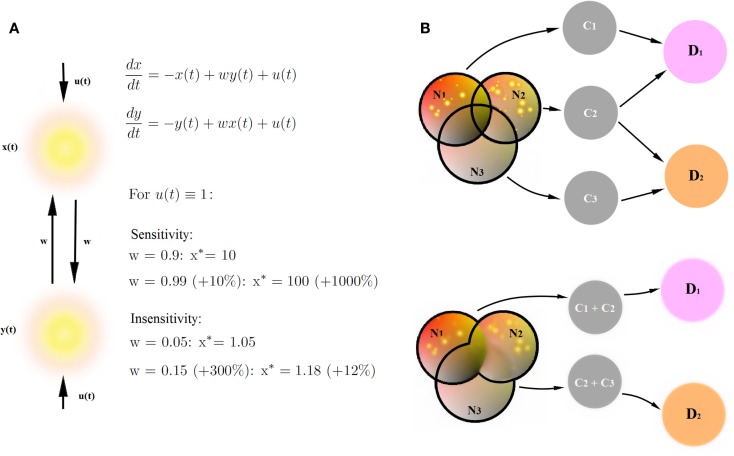Figure 4.
Benefits of CCM. (A) Stable connectivity patterns and connectivity strengths are two sides of the same coin. Let us assume that our sigmoidal transfer function can be approximated as a simple linear function. We provide an example of a network sensitive to changes in connectivity strengths (a small change in connection weights yields an huge change in the value of stable activation patterns) and an example of a network insensitive to changes in connectivity strengths (a huge change in the connectivity strengths yields a small change in stable activation patterns). Therefore, the description of networks by means of dynamical systems provides more versatile description than connectivity strengths in the networks or stable connectivity patterns alone. (B) Decomposition of psychiatric disorders into a number of diagnostic traits helps causal inference in the diagnostic process. Networks Ni underlie cognitive constructs Ci diagnostic to psychiatric disorders Di. Disorders D1 and D2 share a common cognitive construct C2, but involve also disorder-specific diagnostic constructs C1 and C3. Let us assume that the joint posterior distribution for every disorder Di factorizes into posterior probability distributions for single diagnostic constructs. Let us further assume that we find the same, specific pathologies in networks N1 and N2. If we can decompose the D1-related network into a sum of networks N1 and N2 underlying single diagnostic constructs C1 and C2 (upper panel), we collect more evidence for the disorder D1 (pathologies in both networks linked to diagnostic constructs) than for the disorder D2 (pathology in one out of two networks linked to diagnostic constructs). On the other hand, if we are not able to decompose D1 and D2-related networks into networks underlying single diagnostic categories (lower panel), the amount for evidence in favor of both disorders is the same because both networks (N1 + N2) underlying disorder D1 and (N2 + N3) underlying disorder D2 are pathological.

